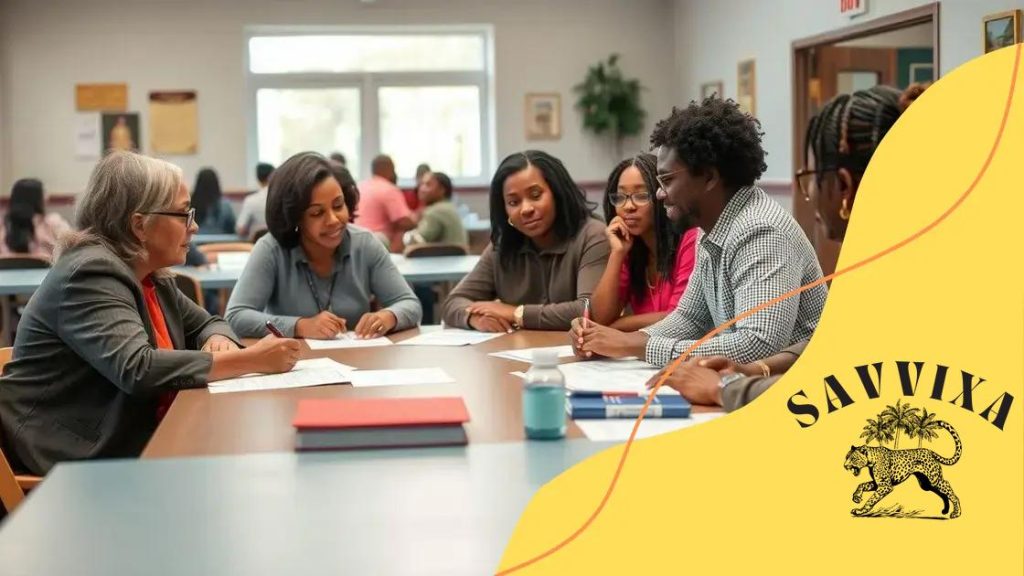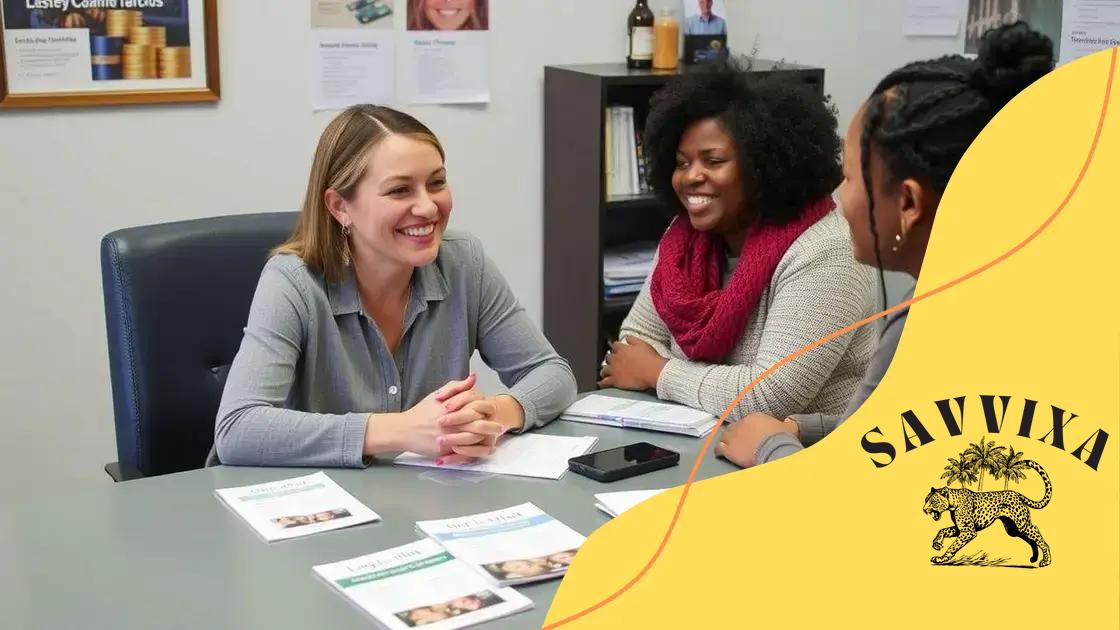Legal aid programs for underserved populations offer hope

Legal aid programs provide essential support to underserved populations by offering free or low-cost legal assistance to ensure access to justice for those who cannot afford legal representation.
Legal aid programs for underserved populations play a vital role in bridging the gap to justice. Have you ever wondered how these initiatives support individuals facing legal challenges? Let’s uncover their significance and impact.
Understanding legal aid programs
Understanding legal aid programs is essential for addressing the needs of those without sufficient resources to navigate the justice system. These programs provide necessary support and ensure that all individuals have access to legal assistance.
At the heart of legal aid is the goal of promoting equity within the legal system. This support is not only critical for individuals but also for communities as a whole.
How Legal Aid Works
Legal aid programs operate through a network of organizations designed to help low-income individuals. These organizations often offer services like legal advice, representation in court, and various forms of support.
Within legal aid programs, there are a few key components:
- Access to qualified attorneys who understand the needs of underserved populations.
- Programs that focus on various legal issues, including housing, immigration, and family law.
- Free or low-cost services that remove financial barriers for those in need.
Moreover, legal aid ensures that individuals are not left to manage legal challenges on their own. Accessing legal assistance can lead to better outcomes in legal representation and advocacy.
The Impact on Communities
The impact of legal aid programs extends far beyond individual cases. They serve as a foundation for social justice. By empowering people to understand and exercise their rights, these programs foster resilience among communities.
For example, community awareness campaigns often promote available legal resources. This can help individuals identify their rights and access important services. Engaging with local organizations that support legal aid can also help build a network of advocacy.
Without such support, many would face legal challenges alone, often resulting in unfavorable outcomes. The work of legal aid providers helps lead to a more just and equitable society.
In summary, understanding legal aid programs reveals their significant role in supporting underserved populations. They not only provide crucial services but also empower communities to advocate for their rights effectively. Legal aid is a lifeline, ensuring that justice is accessible for everyone.
The importance of legal aid for underserved communities
The importance of legal aid for underserved communities cannot be overstated. These programs play a crucial role in ensuring that everyone has access to justice, regardless of their financial situation.
When individuals encounter legal issues such as eviction, domestic violence, or unfair employment practices, having access to legal aid can make a significant difference. It empowers communities by providing necessary legal resources and support.
Access to Justice
Legal aid ensures that people in underserved communities can navigate the legal system effectively. For many, the fear of not understanding legal processes can be overwhelming. Legal aid providers simplify these processes, helping individuals access their rights.
- Legal aid organizations often assist with basic legal advice.
- Free representation in court for those unable to afford an attorney.
- Educational resources to inform individuals of their rights.
Beyond the individual cases, legal aid serves as a fundamental pillar for community empowerment. When communities understand their legal rights, they become more resilient and capable of advocating for themselves.
Breaking the Cycle of Poverty
Access to legal support helps break the cycle of poverty experienced by many in underserved communities. With legal aid, individuals can resolve issues that hinder their economic stability. For instance, fair housing practices can help families remain in their homes and contribute positively to their neighborhoods.
Each successful case leads to better awareness of rights and encourages others to seek help. When more people are informed, the overall community benefits and begins to strengthen.
In addition, the impact of legal aid creates a trickle-down effect that promotes social justice and equality. By ensuring that marginalized populations receive the representation they deserve, society moves toward a more equitable legal system. Ultimately, legal aid is not just about legal services; it’s about restoring dignity and hope to individuals.
How to access legal aid services

Accessing legal aid services is essential for individuals in need of legal assistance. Understanding how to find and utilize these services can empower you to seek justice.
There are various ways to access legal aid, and being informed can significantly improve your chances of getting help. Many communities provide resources that can guide you through this process.
Finding Legal Aid Organizations
The first step in accessing legal aid services is knowing where to look. Many nonprofits focus on helping low-income individuals. You can often find these organizations online through local government websites or legal aid directories.
- Visit the website of your state bar association to find local legal aid providers.
- Search for legal aid clinics in your area that offer free advice.
- Check community centers for information on legal resources available locally.
By using these resources, you can connect with organizations dedicated to assisting people facing legal challenges.
Understanding Eligibility Criteria
Each legal aid service has its own eligibility guidelines. It’s important to review these criteria before applying. Generally, factors such as income level, type of legal issue, and residence may determine your eligibility.
Many legal aid organizations prioritize cases involving critical issues such as homelessness, domestic violence, and employment discrimination. Understanding these priorities can help you present your case more effectively.
After confirming eligibility, the next step is often to complete an application. Applications may require you to provide personal information and details about your legal issue.
Once your application is submitted, the legal aid organization will review your case. If you qualify, they will assign an attorney or connect you with resources for further assistance.
Remember, seeking help early can be crucial. Don’t hesitate to reach out to a legal aid organization as soon as you identify a legal issue. Early intervention can make a significant difference in your case.
Success stories of legal aid assistance
Success stories of legal aid assistance highlight the transformative power of these programs. They showcase how access to legal support can change lives and empower individuals.
One notable story involves a single mother who faced eviction. With the help of a local legal aid organization, she received legal representation. The attorney advocated for her rights and negotiated a new lease agreement. This not only secured her housing but also provided stability for her children.
Empowerment Through Representation
Many individuals have found their voices through legal aid. For example, a young immigrant was facing deportation due to a misunderstanding of her immigration status. A legal aid attorney stepped in, helping her navigate the complex immigration laws.
- Through legal representation, she was able to present her case effectively.
- The intervention resulted in her securing a work permit, allowing her to support her family.
- Her success story inspired others in her community to seek help.
Such experiences highlight the critical role legal aid plays in ensuring justice for those who might otherwise be overlooked.
Community Change
Success stories often extend beyond individual cases to create waves of positive change within communities. For instance, a legal aid program focused on housing rights successfully advocated for better landlord-tenant laws in their city. Their efforts resulted in improved living conditions for many residents.
This illustrates how legal aid can drive systemic change, benefiting entire neighborhoods. By addressing injustice at a grassroots level, these organizations help create environments where residents feel secure and valued.
Moreover, when people share their success stories, it encourages others to seek assistance. Awareness becomes a powerful tool in combating legal challenges.
Challenges faced by legal aid organizations
Challenges faced by legal aid organizations greatly impact their ability to provide help. Despite their importance, many organizations struggle with various obstacles that limit their effectiveness.
One significant challenge is securing adequate funding. Many legal aid organizations rely on grants and donations, which can be unpredictable. As funding fluctuates, these organizations may have to reduce services or limit their outreach efforts.
Workforce Limitations
Another hurdle is the lack of qualified staff. Many legal aid offices experience high turnover rates due to the emotional stress associated with the work and lower salaries compared to private sector positions.
- Recruiting new attorneys and support staff can be difficult.
- Training new employees takes time, affecting service delivery.
- Volunteers can help, but they may also require training and supervision.
This staffing issue can lead to longer wait times for clients seeking assistance, which may discourage individuals from reaching out for help.
Increasing Demand for Services
The demand for legal aid services continues to grow, especially during times of economic hardship. More people are experiencing legal problems related to housing, employment, and family issues, which increases case loads for legal aid organizations.
Many organizations find it challenging to keep up with this rising demand. This situation can overwhelm available resources, leading to situations where individuals must wait long periods to receive legal support.
In conclusion, while legal aid organizations play a critical role in helping underserved populations, they face numerous challenges that affect their ability to operate effectively. Addressing these challenges is crucial to ensuring access to justice for those in need.
FAQ – Questions about Legal Aid Programs
What are legal aid programs?
Legal aid programs provide free or low-cost legal assistance to individuals who cannot afford a lawyer, ensuring access to justice.
Who is eligible for legal aid services?
Eligibility for legal aid services typically depends on income level, the type of legal issue, and residency in the service area.
How can I find a legal aid organization near me?
You can find legal aid organizations by visiting your state bar association’s website or searching for local legal aid clinics and nonprofits.
What challenges do legal aid organizations face?
Legal aid organizations often struggle with funding limitations, increasing demand for services, and staff shortages, affecting their ability to help.